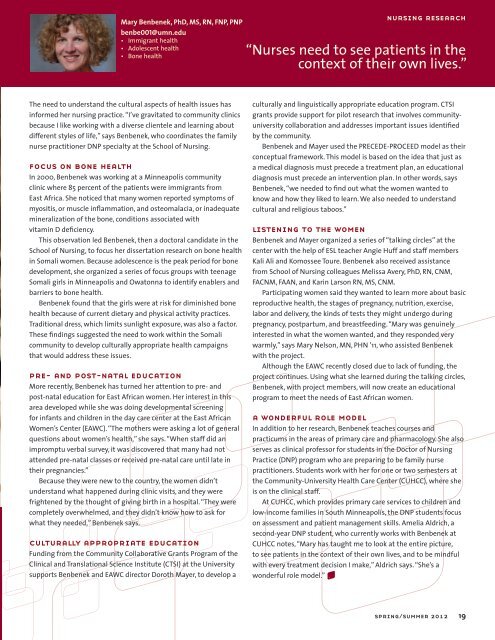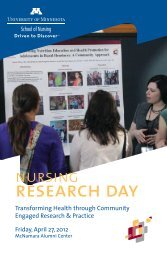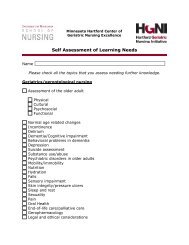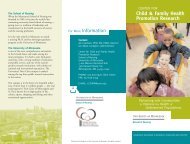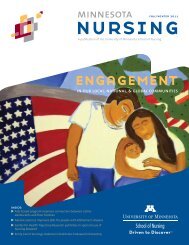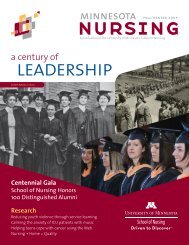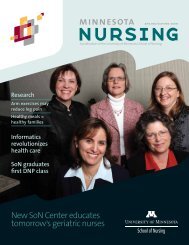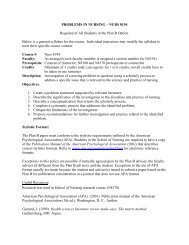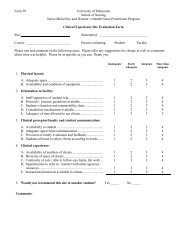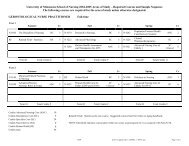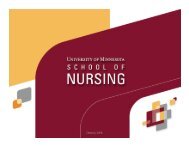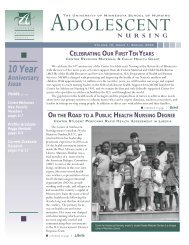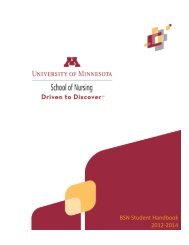Minnesota Nursing Magazine Spring/Summer 2012 - School of ...
Minnesota Nursing Magazine Spring/Summer 2012 - School of ...
Minnesota Nursing Magazine Spring/Summer 2012 - School of ...
You also want an ePaper? Increase the reach of your titles
YUMPU automatically turns print PDFs into web optimized ePapers that Google loves.
Mary Benbenek, PhD, MS, RN, FNP, PNP<br />
benbe001@umn.edu<br />
• Immigrant health<br />
• Adolescent health<br />
• Bone health<br />
nursing research<br />
research<br />
“Nurses need to see patients in the<br />
context <strong>of</strong> their own lives.”<br />
The need to understand the cultural aspects <strong>of</strong> health issues has<br />
informed her nursing practice. “I’ve gravitated to community clinics<br />
because I like working with a diverse clientele and learning about<br />
different styles <strong>of</strong> life,” says Benbenek, who coordinates the family<br />
nurse practitioner DNP specialty at the <strong>School</strong> <strong>of</strong> <strong>Nursing</strong>.<br />
focus on bone health<br />
In 2000, Benbenek was working at a Minneapolis community<br />
clinic where 85 percent <strong>of</strong> the patients were immigrants from<br />
East Africa. She noticed that many women reported symptoms <strong>of</strong><br />
myositis, or muscle inflammation, and osteomalacia, or inadequate<br />
mineralization <strong>of</strong> the bone, conditions associated with<br />
vitamin D deficiency.<br />
This observation led Benbenek, then a doctoral candidate in the<br />
<strong>School</strong> <strong>of</strong> <strong>Nursing</strong>, to focus her dissertation research on bone health<br />
in Somali women. Because adolescence is the peak period for bone<br />
development, she organized a series <strong>of</strong> focus groups with teenage<br />
Somali girls in Minneapolis and Owatonna to identify enablers and<br />
barriers to bone health.<br />
Benbenek found that the girls were at risk for diminished bone<br />
health because <strong>of</strong> current dietary and physical activity practices.<br />
Traditional dress, which limits sunlight exposure, was also a factor.<br />
These findings suggested the need to work within the Somali<br />
community to develop culturally appropriate health campaigns<br />
that would address these issues.<br />
pre- and post-natal education<br />
More recently, Benbenek has turned her attention to pre- and<br />
post-natal education for East African women. Her interest in this<br />
area developed while she was doing developmental screening<br />
for infants and children in the day care center at the East African<br />
Women’s Center (EAWC). “The mothers were asking a lot <strong>of</strong> general<br />
questions about women’s health,” she says. “When staff did an<br />
impromptu verbal survey, it was discovered that many had not<br />
attended pre-natal classes or received pre-natal care until late in<br />
their pregnancies.”<br />
Because they were new to the country, the women didn’t<br />
understand what happened during clinic visits, and they were<br />
frightened by the thought <strong>of</strong> giving birth in a hospital. “They were<br />
completely overwhelmed, and they didn’t know how to ask for<br />
what they needed,” Benbenek says.<br />
culturally appropriate education<br />
Funding from the Community Collaborative Grants Program <strong>of</strong> the<br />
Clinical and Translational Science Institute (CTSI) at the University<br />
supports Benbenek and EAWC director Doroth Mayer, to develop a<br />
culturally and linguistically appropriate education program. CTSI<br />
grants provide support for pilot research that involves communityuniversity<br />
collaboration and addresses important issues identified<br />
by the community.<br />
Benbenek and Mayer used the PRECEDE-PROCEED model as their<br />
conceptual framework. This model is based on the idea that just as<br />
a medical diagnosis must precede a treatment plan, an educational<br />
diagnosis must precede an intervention plan. In other words, says<br />
Benbenek, “we needed to find out what the women wanted to<br />
know and how they liked to learn. We also needed to understand<br />
cultural and religious taboos.”<br />
listening to the women<br />
Benbenek and Mayer organized a series <strong>of</strong> “talking circles” at the<br />
center with the help <strong>of</strong> ESL teacher Angie Huff and staff members<br />
Kali Ali and Komossee Toure. Benbenek also received assistance<br />
from <strong>School</strong> <strong>of</strong> <strong>Nursing</strong> colleagues Melissa Avery, PhD, RN, CNM,<br />
FACNM, FAAN, and Karin Larson RN, MS, CNM.<br />
Participating women said they wanted to learn more about basic<br />
reproductive health, the stages <strong>of</strong> pregnancy, nutrition, exercise,<br />
labor and delivery, the kinds <strong>of</strong> tests they might undergo during<br />
pregnancy, postpartum, and breastfeeding. “Mary was genuinely<br />
interested in what the women wanted, and they responded very<br />
warmly,” says Mary Nelson, MN, PHN ’11, who assisted Benbenek<br />
with the project.<br />
Although the EAWC recently closed due to lack <strong>of</strong> funding, the<br />
project continues. Using what she learned during the talking circles,<br />
Benbenek, with project members, will now create an educational<br />
program to meet the needs <strong>of</strong> East African women.<br />
a wonderful role model<br />
In addition to her research, Benbenek teaches courses and<br />
practicums in the areas <strong>of</strong> primary care and pharmacology. She also<br />
serves as clinical pr<strong>of</strong>essor for students in the Doctor <strong>of</strong> <strong>Nursing</strong><br />
Practice (DNP) program who are preparing to be family nurse<br />
practitioners. Students work with her for one or two semesters at<br />
the Community-University Health Care Center (CUHCC), where she<br />
is on the clinical staff.<br />
At CUHCC, which provides primary care services to children and<br />
low-income families in South Minneapolis, the DNP students focus<br />
on assessment and patient management skills. Amelia Aldrich, a<br />
second-year DNP student, who currently works with Benbenek at<br />
CUHCC notes, “Mary has taught me to look at the entire picture,<br />
to see patients in the context <strong>of</strong> their own lives, and to be mindful<br />
with every treatment decision I make,” Aldrich says. “She’s a<br />
wonderful role model.”<br />
spring/summer <strong>2012</strong> 19


